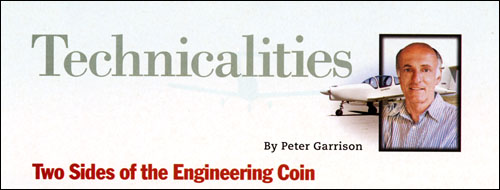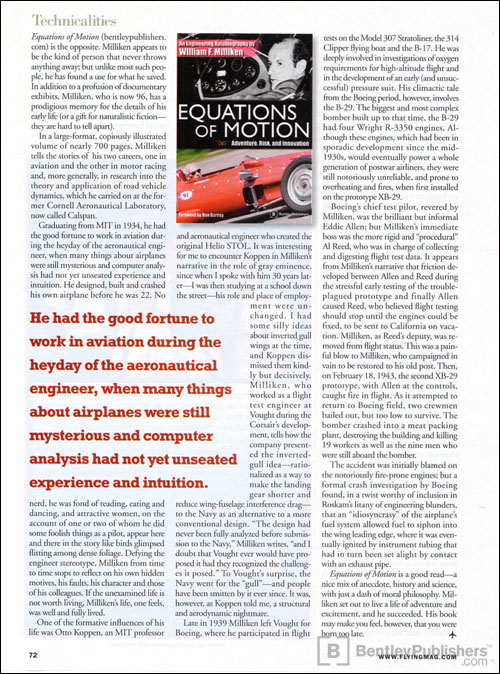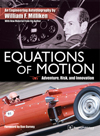|
Equations of Motion -
Adventure, Risk and Innovation
Price: $39.95
|

Flying - October, 2007
Review of Equations of Motion from Flying - October, 2007
Technicalities
Two Sides of the Engineering Coin
ENGINEERS HAVE JOINED PRIESTS, RABBIS, lawyers, Poles and blondes in the casts of corny jokes. Their role is that of the Asberger"s-afflicted idiot savant incapable of discerning the human consequences of design decisions. One hoary example involves the engineer who is about to be beheaded when the guillotine blade gets stuck, and-well, you know the rest. Anyway, I"m sure there are some kinds of engineering jobs that do not require much imagination or empathy; but aeronautical engineering is not one of them.
...
If Roskam"s Lessons Learned is at times a little too perfunctory, William Milliken"s Equations of Motion (bentleypublishers.com) is the opposite. Milliken appears to be the kind of person that never throws anything away; but unlike most such people, he has found a use for what he saved. In addition to a profusion of documentary exhibits, Milliken, who is now 96, has a prodigious memory for the details of his early life (or a gift for naturalistic fiction ? they are hard to tell apart).
In a large-format, copiously illustrated volume of nearly 700 pages, Milliken tells the stories of his two careers, one in aviation and the other in motor racing and, more generally, in research into the theory and application of road vehicle dynamics, which he carried on at the former Cornell Aeronautical Laboratory, now called Calspan.
Graduating from MIT in 1934, he had the good fortune to work in aviation during the heyday of the aeronautical engineer, when many things about airplanes were still mysterious and computer analysis had nor yet unseated experience and intuition. He designed, built and crashed his own airplane before he was 22. No nerd, he was fond of reading, eating and dancing, and attractive women, on the account of one or two of whom he did some foolish things as a pilot, appear here and there in the story like birds glimpsed flitting among dense foliage. Defying the: engineer stereotype, Milliken from time to time stops to reflect on his own hidden motives, his faults, his character and those of his colleagues. If the unexamined life is not worth living, Milliken"s life, one feels, was well and fully lived.
One of the formative influences of his life was Otto Koppen, an MIT professor and aeronautical engineer who created me original Helio STOL. It was interesting for me to encounter Koppen in Milliken"s narrative in the role of gray eminence, since when I spoke with him 30 years later - I was then studying at a school down the street - his role and place of employment were unchanged. I had some silly ideas about inverted gull wings at the time, and Koppen dismissed them kindly but decisively. Milliken, who worked as a flight test engineer at Vought during the Corsair"s development, tells how the company presented the inverted gull idea rationalized as a way to make the landing gear shorter and reduce wing-fuselage interference drag ? to the Navy as an alternative to a more conventional design. "The design had never been fully analyzed before submission to the Navy," Milliken writes, "and I doubt that Vought ever would have proposed it had they recognized the challenges it posed." To Vought's surprise, the Navy went for the "gull" - and people have been smitten by it ever since. It was, however, as Koppen told me, a structural and aerodynamic nightmare.
Late in 1939 Milliken left Vought for Boeing, where he participated in flight tests on the Model 307 Stratoliner, the 314 Clipper flying boat and the B-17. He was deeply involved in investigations of oxygen requirements for high-altitude flight and in the development of an early (and unsuccessful) pressure suit. His climactic tale from the Boeing period, however, involves the B-29. The biggest and most complex bomber built up to that time, the B-29 had four Wright R-3350 engines. Although these engines, which had been in sporadic development since the mid-1930s, would eventually power a whole generation of postwar airliners, they were still notoriously unreliable, and prone to overheating and fires, when first installed on the prototype XB-29.
Boeing"s chief test pilot, revered by Milliken, was the brilliant but informal Eddie Allen; but Milliken"s immediate boss was the more rigid and "procedural" Al Reed, who was in charge of collecting and digesting flight test data. It appears from Milliken"s narrative that friction developed between Allen and Reed during the stressful early testing of the trouble-plagued prototype and finally Allen caused Reed, who believed flight testing should stop until the engines could be fixed, to be sent to California on vacation. Milliken, as Reed"s deputy, was removed from flight status. This was a painful blow to Milliken, who campaigned in vain to be restored to his old post. Then, on February 18, 1943, the second XB-29 prototype, with Allen at the controls, caught fire in flight. As it attempted to return to Boeing field, two crewmen bailed out, but too low to survive. The bomber crashed into a meat packing plant, destroying the building and killing 19 workers as well as the nine men who were still aboard the bomber.
The accident was initially blamed on the notoriously fire-prone engines; but a formal crash investigation by Boeing found, in a twist worthy of inclusion in Roskam"s litany of engineering blunders, that an "idiosyncrasy" of the airplane"s fuel system allowed fuel to siphon into the wing leading edge, where it was eventually ignited by instrument tubing that had in turn been set alight by contact with an exhaust pipe.
Equations of Motion is a good read-a nice mix of anecdote, history and science, with just a dash of moral philosophy. Milliken set out to live a life of adventure and excitement, and he succeeded. His book may make you feel, however, that you were born too late.


Review of Equations of Motion from Flying - October, 2007 - Page
![[B] Bentley Publishers](http://assets1.bentleypublishers.com/images/bentley-logos/bp-banner-234x60-bookblue.jpg)
